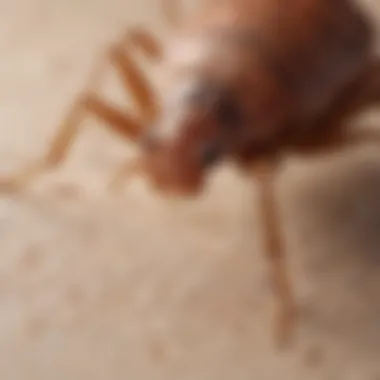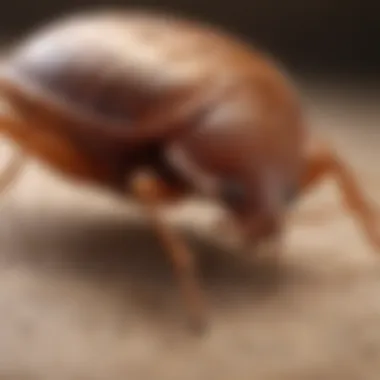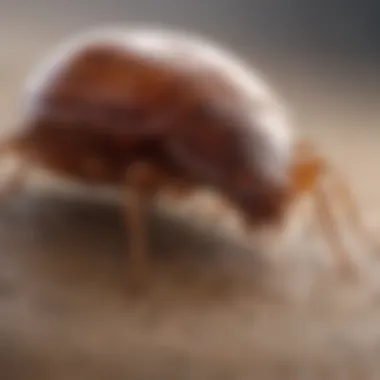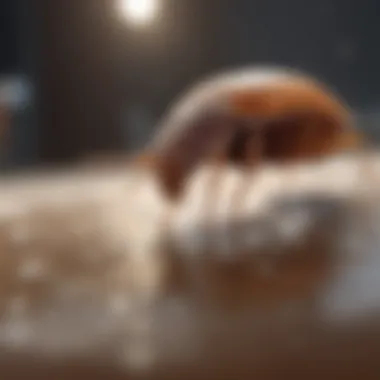Understanding Bed Bug Rashes: Symptoms and Treatments


Intro
Bed bugs are small, elusive insects that have created a significant concern for many households. Though they do not transmit diseases, their bites can lead to considerable discomfort. Identifying the signs of a bed bug rash is crucial in addressing the problem quickly. Ignoring the symptoms may result in escalating issues, both with the pests and the associated skin reactions. This article will break down the characteristics of bed bug rashes, with an emphasis on symptoms, identification, and treatment.
Fascinating Facts About the Animal
Unique Characteristics
Bed bugs, scientifically known as Cimex lectularius, possess several distinct traits. They are flattened, wingless, and have a reddish-brown coloration, which helps them blend into their surroundings. Adult bed bugs can grow up to five millimeters in length. Their small size and agility allow them to hide in narrow crevices, making them difficult to spot. One remarkable fact is that they can survive several months without feeding, adapting to various living conditions.
Extraordinary Abilities
Bed bugs demonstrate notable abilities as well. They can detect carbon dioxide and heat, guiding them to potential hosts efficiently. Their piercing mouthparts allow them to feed on blood, typically during the night when their prey is asleep. This feeding behavior is often the first indication of an infestation, as bites typically occur without the individual waking up. According to recent studies, bed bugs can also reproduce rapidly; a female can lay hundreds of eggs in her lifetime, leading to an increase in infestation levels, if not addressed promptly.
Behavior and Habitat
Natural Habitats
Bed bugs thrive in various environments, often favoring areas where humans reside. They are commonly found in hotels, motels, dormitories, and even public transportation. Cracks in walls, furniture, and bedding are typical locations for these insects to hide. Their adaptability makes them a persistent problem in urban areas where high population densities create ideal conditions for their spread.
Social Structures
Bed bugs do not exhibit complex social structures like other insects. Instead, they are solitary when feeding but can coexist in groups during infestation. Their primary focus is on finding food, typically when they sense the right conditions. Understanding their behavior can aid in preventing infestations and identifying the rashes resulting from their bites.
Recent Scientific Discoveries
Latest Research Findings
Recent research has shed light on the resilience of bed bugs. Increased resistance to common insecticides has raised alarm among pest control teams. Studies reveal that some bed bug populations have developed genetic mutations that allow them to survive after exposure to chemical treatments.
Breakthroughs in Animal Biology
Breakthroughs in bed bug biology have also provided insights into their cooperative behaviors during feeding and resting periods. Researchers have found that specific chemical signals help facilitate their feeding habits. This knowledge is vital for developing effective treatment strategies and understanding the biological mechanisms influencing bed bug infestations.
Cultural Significance
Animals in Folklore
Though often seen as a nuisance, bed bugs have influenced human behavior and culture. They can appear in folklore as symbols of uncleanliness or misfortune, serving as reminders of the importance of hygiene and cleanliness in living spaces.
Influence on Art and Literature
Bed bugs, due to their persistent nature, have also found their way into literature and art as representations of discomfort and the unseen aspects of life. They serve as a cautionary tale about the potential consequences of neglecting personal space and hygiene.
In summary, bed bugs are remarkable but problematic creatures with unique characteristics and an ability to adapt. Understanding their biology, behavior, and cultural significance can aid in managing infestations and treating rashes associated with their bites. This knowledge is crucial for both prevention and treatment, making it essential for individuals dealing with these pests.
Intro to Bed Bugs
Understanding bed bugs is crucial for anyone dealing with potential infestations. These pests not only invade homes but can also lead to discomfort and distress for those affected. This section lays the foundation for comprehending the issues surrounding bed bug rashes and their implications. Knowing about bed bugs helps in early identification and in implementing effective treatment.
The biology of bed bugs informs the readers about their lifecycle and feeding habits. This is essential because it directly relates to how rashes appear after bites. Moreover, recognizing their common habitats and behavior aids individuals in spotting infestations sooner. The correlation between an understanding of the pest and the resultant health implications cannot be overstated. By examining both aspects, readers can better navigate the challenges posed by these insects.
The Biology of Bed Bugs
Bed bugs, scientifically known as Cimex lectularius, are small, wingless insects that feed on the blood of humans and animals. Their tiny, flat bodies allow them to hide in various crevices, making them difficult to detect. Adult bed bugs are about the size of an apple seed and can be identified by their reddish-brown color. They undergo a process of gradual metamorphosis, transitioning from eggs to nymphs and finally to adults.
Female bed bugs are capable of laying hundreds of eggs during their lifespan, resulting in rapid population increases if not managed effectively. Each stage of their lifecycle relies on a blood meal for growth and development, which is where the connection to rashes emerges. When bed bugs bite, they inject saliva that can cause allergic reactions in some individuals, leading to various symptoms.
Common Habitats and Behavior
Bed bugs typically thrive in environments where humans sleep. They are commonly found in hotels, apartments, and even public transportation. Their preferred hiding spots include:


- Mattresses and box springs
- Bed frames
- Furniture seams and cushions
- Behind baseboards and wallpaper
Understanding the behavior of bed bugs is key to prevention. They are primarily nocturnal, emerging at night to feed. Their presence is often unnoticed until bites occur, making it essential for individuals to be vigilant and proactive.
Recognizing these habitats can help in preventing infestations or responding effectively if they do occur. Examining sleeping areas and being aware of bed bug signs, like dark spots or shed skins, can significantly alleviate the impact on individuals and families.
Identifying Bed Bug Bites
Identifying bed bug bites is crucial for individuals suspecting an infestation. The first step in managing a bed bug problem is to recognize whether the rashes or bites on the skin are indeed from these pests. Accurate identification aids in timely treatment and prevents further discomfort or skin complications. Knowing the specific characteristics of bed bug bites can enhance understanding and prevention strategies, making it an invaluable section in any comprehensive guide on this topic.
Initial Symptoms of a Bed Bug Bite
Bed bug bites can often be mistaken for those of other insects. The initial symptoms typically surface soon after being bitten, making it important to observe changes on the skin. Generally, the bites appear as small, raised welts that may be red and swollen. They often develop in a line or cluster, which is a distinctive feature of bed bug activity.
Some common initial symptoms include:
- Itching: Often the first and most noticeable symptom, with varying degrees of intensity.
- Redness: Localized redness around the bites is typical, indicating an inflammation response.
- Bumps: Raised welts that can be uncomfortable or painful without proper care.
Most of these symptoms manifest within a few hours to days following the bite. However, the severity of the reaction can differ among individuals due to various factors like skin sensitivity or prior exposure to bed bug bites.
Delaying Reactions and Severity
While some people may experience immediate symptoms, others might notice a delayed reaction. In such cases, redness and swelling may appear several days after the initial bite. This delay provides a unique challenge in identifying bed bug bites, as the bites may not be associated with recent infestations.
The severity of a bed bug bite also varies. Some individuals can show a strong allergic reaction that leads to extensive swelling and additional related symptoms. On the other hand, many individuals have minor reactions that require little to no medical attention. It is essential to monitor symptoms and recognize warning signs.
An important consideration includes:
- Warning signs of infection: If the bite area becomes increasingly red, warm, or pus-filled, seeking medical advice is wise.
- Persistent itching: Severe itching can lead to scratching, which raises the risk of secondary infections.
In summary, understanding the initial symptoms and recognizing any delayed reactions is key to effectively identifying bed bug bites. Proper identification is essential to implement timely treatment and avoid complications.
What Does a Bed Bug Rash Look Like?
Understanding the specific appearance of bed bug rashes is crucial for both diagnosis and treatment. Recognizing what these rashes look like helps individuals to take appropriate action quickly. With proper identification, one can avoid confusion with other skin conditions that may have similar characteristics. This is particularly important for preventing potential secondary infections and alleviating discomfort.
Visual Characteristics
Bed bug rashes often present as small, red welts on the skin. These welts usually vary in size, ranging from 2 to 5 millimeters in diameter. The rash may start as flat spots that then can become raised. The location of these rashes commonly corresponds to areas where bed bugs tend to feed: usually on exposed skin while a person sleeps, such as arms, legs, neck, and face.
It is important to note that while the redness is typically prominent, some individuals may experience paler centers within the welts. This can sometimes contribute to confusion regarding the exact nature of the rash.
Common Patterns and Distribution
The pattern of bed bug rashes often follows a distinct configuration. Bites can appear in small clusters or linear formations, typically along skin folds or areas that are not covered by bedding or clothing. This linear arrangement can be useful for clarity in diagnosing bed bug bites versus bites from other insects.
In addition, the distribution of the rashes tends to vary based on the severity of the infestation. In mild cases, a few welts may appear sporadically. In contrast, in severe infestations, multiple clusters may be present over larger areas of the body. Understanding these patterns aids in not only confirming the presence of a bed bug but also in taking necessary measures to address the issue effectively.
Color and Texture Analysis
The color of a bed bug rash is generally red or pink, but some individuals experience varying shades due to skin types and reactions. For instance, those with lighter skin may see a more pronounced flush, while darker skin may exhibit deeper hues.
The texture of the skin surrounding the rash may also change. Commonly, the area can feel warm to the touch and may accompany swelling. Intense itching is usually present, which can lead to scratching. Scratching may exacerbate the rash, leading to further irritation and the risk of secondary infections.
Bed bug rashes can easily be mistaken for other insect bites, making accurate identification essential for effective treatment.
In summary, understanding the visual characteristics, common patterns, and color textures of bed bug rashes is key for effective management. It allows individuals to recognize when they have encountered an infestation and take proper steps towards treatment and prevention.
Differentiating Bed Bug Rashes from Other Conditions
Understanding how to distinguish bed bug rashes from other skin conditions is crucial for accurate diagnosis and treatment. Bed bug bites often resemble those from other pests, which can lead to misdiagnosis and improper treatment. This section will elaborate on the importance of making these distinctions efficiently, ensuring that the symptoms are recognized correctly. This knowledge not only helps in effective treatment but also plays a critical role in pest control strategies.


Comparison with Flea Bites
Flea bites can often be confused with bed bug bites because both produce similar itchy, red welts on the skin. However, there are some distinguishing features.
- Flea bites are commonly found around the ankles and lower legs, while bed bug bites can occur anywhere on the body.
- Flea bites usually appear as small, red dots and may have a halo effect. In contrast, bed bug bites can form in clusters or rows.
The timing of the bites is also different. Fleas tend to feed during the day, while bed bugs are primarily nocturnal feeders. Understanding these differences can help individuals identify the source of the rash more accurately.
Identifying Allergic Reactions
Another critical aspect is recognizing allergic reactions. Skin reactions can arise from various allergens beyond just bed bugs. For instance, reactions to chemicals in soaps, detergents, or personal care products may mimic the symptoms of bed bug rashes.
- Allergic reactions usually develop quickly after exposure to an allergen.
- The rash might include symptoms such as swelling, hives, and redness that can be widespread.
Differentiating these symptoms from those of bed bug bites is important, as itching associated with allergies can lead to unnecessary scratching, which might exacerbate the condition. Keeping track of recent product changes may assist in identifying the cause.
Recognizing Other Skin Irritations
Skin irritations from non-insect sources can also create confusion. Conditions such as eczema, psoriasis, or dermatitis can produce red rashes that may look similar to bed bug bites. These are generally chronic and have separate triggers:
- Eczema tends to have dry patches of skin and may also occur in individuals with a family history of skin conditions.
- Psoriasis usually presents as well-defined, scaly patches on specific body areas.
Each of these conditions requires its own treatment and prevention strategies. Accurate identification helps in managing symptoms effectively and avoiding complications.
It is essential to note that self-diagnosis is insufficient. Consulting a healthcare professional for a proper evaluation is advisable when unsure about what condition may be present.
Associated Symptoms of Bed Bug Infestation
Understanding the associated symptoms of bed bug infestation is critical for those who suspect they may be experiencing this trouble. The physical signs—including rashes and itchiness—are just part of the bigger picture. Familiarizing oneself with these symptoms helps in swift recognition and effective treatment, reducing the chances of further complications.
Itching and Inflammation Characteristics
One of the most prominent symptoms associated with bed bug bites is the itching. Initially, the bites may resemble mosquito bites, but they can evolve into more pronounced rashes. The itchiness can lead to intense discomfort, prompting scratching that aggravates the skin. Inflammatory responses may include redness and swelling near the bitten area. This reaction varies from person to person, depending on their sensitivity and immune response.
Common Features of Itching and Inflammation:
- Red, raised welts on the skin
- Flare-ups can expand from the original bite area
- Variation in intensity: mild to severe
It's important to note that scratching the inflamed area can lead to secondary issues, which brings us to the next topic of concern.
Potential Secondary Infections
Secondary infections often arise from the act of scratching itchy areas affected by bed bug bites. While the initial symptoms relate to the bites themselves, the risk of infection amplifies when compromised skin allows pathogens to enter. This can lead to the proliferation of bacteria or fungi, causing more serious conditions such as cellulitis.
Signs of Potential Secondary Infections Include:
- Increased redness around the bite
- Swelling that does not subside
- Pus or drainage from the bite site
- Development of fever or chills
In such cases, it is crucial to consult a healthcare professional. Taking prompt action can prevent complications, ensuring well-being and thereby addressing the broader issues linked to bed bug infestations.
Important: Control measures and treatment regimens should always combine the management of symptoms and addressing the source of infestations to ensure long-term relief.
Understanding these associated symptoms provides insight not only into the immediate reactions of the body but also into necessary precautions that can be taken to mitigate further problems.
Effective Treatment Options for Bed Bug Rashes
Effective treatment options for bed bug rashes are essential to mitigate discomfort and prevent further complications. Bed bug bites can lead to considerable itching, inflammation, and even secondary infections if not properly treated. Understanding the available treatment options allows individuals to manage symptoms effectively while addressing the underlying issue of a bed bug infestation.
Topical Treatments and Their Efficacy
Topical treatments are often the first line of defense against bed bug rashes. These treatments aim to relieve itching, reduce inflammation, and promote healing. Common options include:


- Hydrocortisone cream: This over-the-counter medication helps decrease inflammation and redness in the affected area.
- Antihistamines: Creams or lotions containing antihistamines can be applied to reduce allergic reactions, alleviating itchiness.
- Calamine lotion: This soothing lotion can provide relief from itching and act as a skin protectant.
While topical treatments can be effective, their efficacy varies among individuals. It is important to follow the instructions provided on the packaging or as advised by a healthcare professional. Some people may experience side effects or may find that certain treatments do not provide the expected relief.
Importance of Avoiding Scratches
Avoiding scratches is crucial when dealing with bed bug rashes. Scratching the affected areas can exacerbate the inflammation and lead to further irritation. Moreover, broken skin increases the risk of secondary infections, which may necessitate antibiotics or other medical interventions. Keeping fingernails trimmed and using cold compresses can help reduce the urge to scratch. If necessary, consider wearing gloves while sleeping to prevent accidental scratching during the night.
Remember: Scratching can turn a minor issue into a significant health concern.
When to Seek Professional Help
In some cases, home treatments may not suffice, and it becomes necessary to seek professional help. Consider consulting a healthcare provider under the following circumstances:
- The rash worsens or shows signs of infection, such as increased redness, warmth, swelling, or pus.
- Symptoms persist beyond a week despite treatment efforts.
- You begin to experience other systemic symptoms, including fever or excessive fatigue.
By recognizing these warning signs early, individuals can avoid complications and ensure appropriate treatment. Healthcare professionals can provide tailored plans, whether through prescription medications or referrals to specialists, ensuring that both the symptoms and the underlying infestation are addressed effectively.
The combination of proper treatment, effective management strategies, and professional intervention, when necessary, contributes to controlling bed bug rashes and alleviating the distress they cause.
Preventing Bed Bug Infestations
Preventing bed bug infestations is crucial. By understanding specific elements of prevention, individuals can effectively avoid the discomfort and stress associated with bed bug rashes and bites. This section outlines practical strategies and considerations for maintaining a bed bug-free environment.
Effective Home Inspection Techniques
Regular inspections of your living space are essential to identify any signs of bed bugs before they become a larger issue. When inspecting your home, focus on these key areas:
- Mattresses and Box Springs: Check seams and folds for tiny brownish spots, which may indicate bed bug feces.
- Furniture: Look under cushions and inside drawers, since bed bugs can hide anywhere they find a crevice.
- Baseboards and Carpets: Pay close attention to areas around baseboards, as well as the edges of carpets.
- Luggage and Bags: Inspect your luggage after travel, particularly if you have been in hotels or shared accommodations.
Regular inspections can help catch bed bugs early, greatly reducing the chances of a significant infestation.
Keeping a routine inspection schedule can help ensure your home remains bed bug-free. Early detection is key.
Best Practices for Travel and Accommodation
Travel is often a primary way that bed bugs spread. Taking preventive measures when traveling can significantly reduce the risk of bringing unwanted pests back home. Here are some best practices:
- Examine Hotel Rooms: Upon arrival, inspect your room thoroughly. Check the mattress, headboard, and furniture for any signs of bed bugs.
- Use Protective Covers: Invest in bed bug-proof mattress and box spring encasements. These can serve as extra barriers against potential infestations.
- Keep Luggage Elevated: Store your luggage on racks, rather than placing it on the bed or floor. This reduces contact with pests that might be hiding in these areas.
- Wash Clothes Promptly: After returning home, wash and dry your clothes on high heat. This can kill any bed bugs that may have stowed away.
Maintaining a Bed Bug-Free Environment
Sustaining a bed bug-free environment involves several proactive measures. Here are strategies you can adopt:
- Declutter Regularly: Less clutter means fewer hiding places for bed bugs. Regularly remove unnecessary items that may accumulate dust and debris.
- Use Regular Vacuuming: Vacuum your home frequently, especially areas where bed bugs are likely to hide. Remember to dispose of the vacuum bag immediately after use.
- Monitor Your Home: Use bed bug monitors, which can alert you to their presence before an infestation develops.
By implementing these best practices consistently, families can maintain a safe and healthy living space, minimizing the risk of bed bug infestations that could lead to skin irritations and rashes.
The End
Understanding bed bug rashes is crucial for anyone who may encounter these pests. Awareness of symptoms, effective identification, and appropriate treatment options can significantly improve your response to infestations. Bed bugs are resilient creatures, and even a minor oversight can lead to larger issues. Proactive measures are necessary not just for treatment, but also for prevention.
The article emphasizes different aspects of bed bug rashes, such as their visual characteristics, common symptoms, and effective treatments. Recognizing these elements allows individuals to differentiate between bed bug rashes and other skin conditions, which can be vital for effective management.
In addition, awareness of effective prevention strategies can help mitigate risks of infestation. By reviewing these recommendations, families, veterinarians, and wildlife biologists gain insights into maintaining environments free of these pests. Regular inspections and careful travel practices can reduce the likelihood of encountering them.
"Knowledge is the first line of defense against bed bug infestations."
This summary encapsulates the nuances of bed bug rashes and their treatment. In seeking knowledge, you equip yourself to deal with potential infestations effectively.
Summary of Key Points
- Bed bug rashes result from bites and are typically marked by redness, itching, and swelling.
- Initial symptoms can emerge hours to days after a bite, which may complicate identification.
- Differentiating bed bug rashes from flea bites and allergic reactions is essential for proper treatment.
- Topical treatments can alleviate discomfort, but aggressive scratching may lead to secondary infections.
- Effective home inspection and travel practices play a significant role in preventing infestations.
Final Recommendations
- Regularly inspect bedding and crevices for signs of bed bugs.
- If a rash develops, keep the area clean and refrain from scratching.
- Consult healthcare professionals for persistent symptoms or severe reactions.
- Implement preventive strategies in travel, including inspecting accommodations and travel gear.
- Seek professional help if an infestation is suspected to counter any potential damage before it escalates.
These recommendations, backed by thorough understanding, help to manage and mitigate bed bug impacts effectively.







